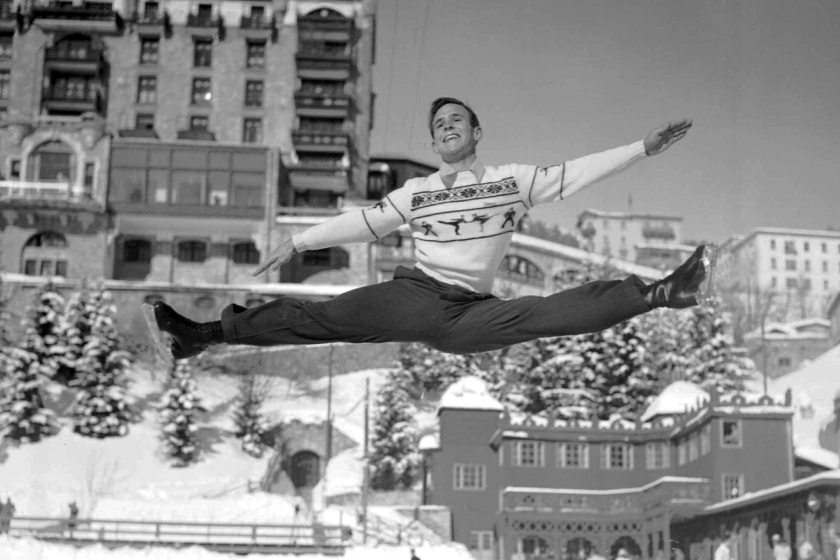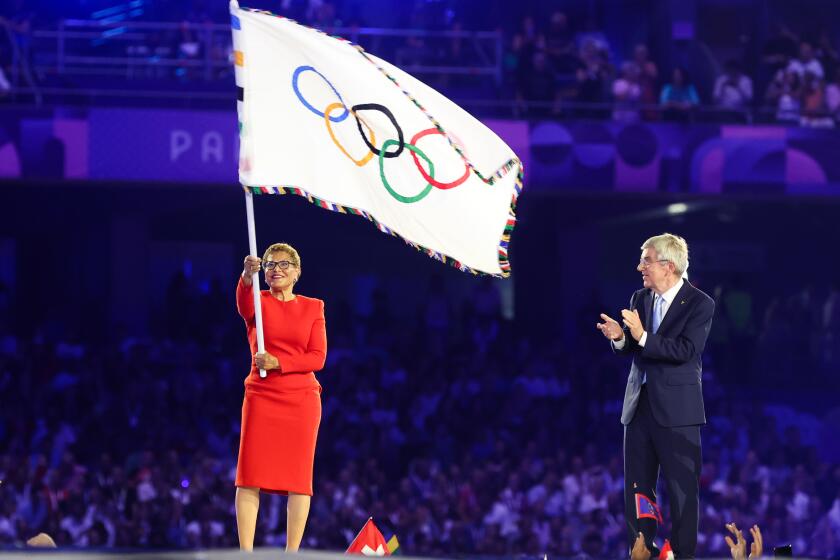Giving Kids a Tumble : Irvine Gymnastics School Offers Program for Underprivileged
- Share via
SANTA ANA — In one corner of the gym, a young girl swings on the high bar, letting go briefly on each downward arc. Behind her, aspiring gymnasts watch and wait their turn, some so small they will need a boost from their coach to reach the bar.
In the other corner, the rest of the class walks the balance beam, on tiptoes, practicing the arms-outstretched dismount they’ve seen on television.
Thousands of Orange County youngsters take part in gymnastics programs like this one at the Irvine School of Gymnastics, their numbers swelling each time the Olympics come around and put a spotlight on the sport and on the latest young star--from Olga Korbut in 1972 to Mary Lou Retton in 1984 to this year’s gold medal hopeful, 16-year-old Kim Zmeskal.
All but absent from most public school programs, gymnastics is mostly the province of private schools and coaches, a situation that puts the sport out of the reach of most low-income families. The 23 underprivileged children learning the basics on this Saturday morning, however, are doing so for free.
The Irvine School of Gymnastics (actually located just over the city line in Santa Ana) is offering the nine-month scholarship program with the help of a one-time grant from the Amateur Athletic Foundation of Los Angeles, which distributes surplus money from the 1984 Olympics to youth sports organizations in Southern California.
Children in the gymnastics program range in age from 7 to 12, and most of them come from Santa Ana. They meet each Saturday for a 1 1/2-hour lesson that opens with a stretching session and goes on to cover all the four areas of gymnastic competition: vault, bars, beam and floor exercise, plus some work on the trampoline. Normally, the program would cost $57 a month.
Of the children asked, all said they never had the opportunity to try gymnastics before. “They love it. They’re really receptive to everything we teach them,” said supervising coach Fred Olivieri. “We think it has to do with this being a new opportunity to them.”
Becky Felix, 11, of Santa Ana said she liked the class because “you get to jump around a lot.” Thuy Doan, a 9-year-old from Santa Ana who likes the bars the best, said there was some fear involved in learning the new sport, but “you get over it.”
Jocelyn Behrens, 10, also of Santa Ana, once took a class in jazz dance but likes gymnastics better because it is “more exciting, more daring,” she said. “I want to stay in.”
Four of the girls in the class live in a protected foster home. “Our girls love it. It’s helping build their confidence and self-esteem,” said one of the girls’ guardians, who asked that she and the home not be identified. There is little money to pay for such programs on the home’s limited budget, she added.
The youngsters in the program were selected with the help of social charities in Santa Ana and elsewhere in Orange County. The fact that none of the participants are boys was not planned, just that more girls are interested in the sport, said Ron Manara, co-owner and head coach of the Irvine School of Gymnastics.
The school, which has about 400 students in both gymnastics and cheerleading, has tried to help youngsters from low-income families before, Manara said, but “we were never able to do something as large as this.”
Absentee levels in the first three months of the class have been near zero, much lower than the school’s other classes. “These kids seem to appreciate it, because they don’t get to do things like this,” Manara said. “We tend to take a lot of things for granted when they come to us easily.”
While the students display enthusiasm and some show ample physical skills, it is too early to tell if there are any exceptional talents among the group. “Gymnastics is not something you just pick up and go,” Manara said. It is possible that some will work their way onto the school’s competitive team, he said.
And what happens after the class ends? Will students be able to continue in gymnastics if they want, or is this a onetime flirtation with a sport? Rich McGann, co-owner of the school, said he would like to find private or corporate sponsors to continue the program after the current grant runs out.
Manara added that if someone does exceptionally well, the school will find some way to continue her training: “What am I going to do, drop her?” He said he would also like to extend the program by offering gymnastics instruction in the public schools.
Since its origin in 1985, the Amateur Athletic Foundation has spent $24 million in grants to youth sports projects. Only a small percentage of the grants has gone to Orange County groups, and there was criticism a couple of years ago that most of these were going to programs catering to well-heeled youngsters.
That may be changing, if the program at the Irvine School of Gymnastics is an indication. Another project that received a grant from the foundation earlier this month is a sailing program administered by Orange Coast College’s Sailing Center in Newport Beach for underprivileged and “at-risk” teen-agers.
The first summer session, with 20 students aged 14 to 18, begins today.
In all, 60 students will learn about sailing in three sessions this summer, and another 40 will receive instruction during the school year, beginning in fall.
“They’ve never had any kind of experience like this before,” said Karen Prioleau, director of the program. “They’ll not only learn how to sail, they’ll learn how to sail well.”
The program’s goal is not only to expose the teens to a new sport, and give them skills in that sport, but to “build their self-esteem and self-confidence,” Prioleau said. “That’s the biggest thing that we emphasize.”
More to Read
Go beyond the scoreboard
Get the latest on L.A.'s teams in the daily Sports Report newsletter.
You may occasionally receive promotional content from the Los Angeles Times.







